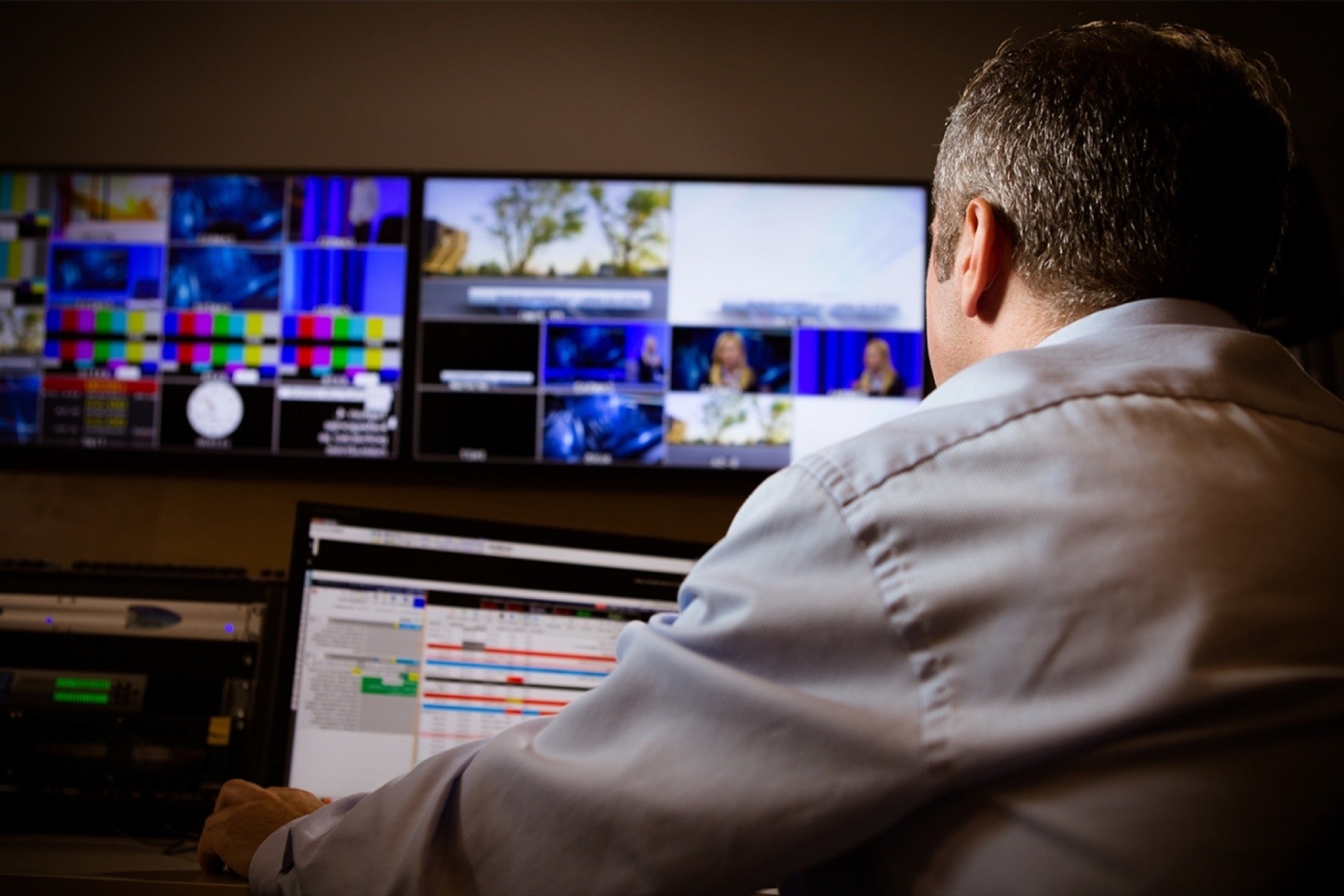Home>Technology>Home Entertainment Systems>What Does The Root Word Tele Mean In Television


Home Entertainment Systems
What Does The Root Word Tele Mean In Television
Modified: January 5, 2024
Discover the meaning of the root word "tele" in television and its relevance to home entertainment systems. Explore the connection between telecommunication and modern home entertainment.
(Many of the links in this article redirect to a specific reviewed product. Your purchase of these products through affiliate links helps to generate commission for Storables.com, at no extra cost. Learn more)
**
Introduction
**
Television has become an integral part of modern society, offering a window to the world and a source of entertainment, information, and connection. The root word "tele" is derived from the Greek word "tēle," which means "far off" or "at a distance." Understanding the significance of this root word provides insight into the essence of television as a medium that brings distant events, stories, and experiences into our homes.
Television, often abbreviated as TV, has undergone remarkable transformations since its inception, shaping the way we receive and interact with information and entertainment. This article delves into the meaning of the root word "tele," explores the history and evolution of television, and examines its profound impact on society. By understanding the root of the word "television," we can gain a deeper appreciation for the technological marvel that has revolutionized communication and entertainment on a global scale.
Key Takeaways:
- The word “tele” in television comes from Greek and means “far off” or “at a distance,” showing how TV brings distant events and stories into our homes, connecting us to the world.
- Television’s impact spans cultural exchange, information sharing, entertainment, and technological progress, uniting people globally through shared experiences and shaping our interconnected world.
Read more: What Does Television Stand For
Definition of Root Word “Tele”
The root word “tele” originates from the Greek word “tēle,” which conveys the concept of distance or remoteness. This prefix has been integrated into various words and phrases to denote actions or phenomena occurring over a distance or involving communication across space. In the context of television, the incorporation of the root word “tele” underscores the medium’s ability to transmit visual and auditory content from distant locations to viewers’ homes.
Furthermore, the prefix “tele” has extended its influence beyond television, permeating numerous aspects of modern communication and technology. It has contributed to the formation of terms such as “telecommunication,” “teleconference,” and “teleport,” all of which emphasize the idea of bridging geographical gaps and enabling remote interaction and transmission.
Understanding the root word “tele” provides a linguistic foundation for comprehending the far-reaching capabilities of television and the interconnectedness it fosters among individuals, communities, and nations. By acknowledging the etymological significance of “tele,” we can appreciate the profound impact of television as a mechanism for sharing experiences, disseminating knowledge, and fostering a sense of global interconnectedness.
History of Television
The history of television traces back to the late 19th century, marked by significant technological advancements and the pioneering efforts of inventors and innovators. The concept of transmitting moving images and accompanying audio over a distance captivated the imagination of numerous visionaries, ultimately leading to the creation of the television as we know it today.
In the early 20th century, inventors such as Paul Nipkow, Boris Rosing, and Vladimir Zworykin made groundbreaking contributions to the development of television technology. Nipkow’s invention of the Nipkow disk in 1884 laid the foundation for the mechanical scanning of images, while Rosing and Zworykin’s work on cathode ray tubes and electronic television systems propelled the evolution of electronic television.
The watershed moment in television history arrived with the first electronic television demonstration by Philo Farnsworth in 1927. Farnsworth’s innovative use of electronic scanning to transmit images set the stage for the modern television era. Subsequently, the introduction of the first fully electronic television system by RCA in the 1930s heralded a new era of mass communication and entertainment.
Television’s ascent continued with the post-World War II proliferation of television sets in households, leading to the widespread adoption of this transformative medium. The introduction of color television in the 1950s further revolutionized the viewing experience, enhancing the visual impact of broadcasts and captivating audiences with vibrant imagery.
As television technology continued to advance, the introduction of cable and satellite television expanded the range of available channels and programming, offering viewers a diverse array of content. The digital revolution in the late 20th and early 21st centuries further transformed television, ushering in high-definition and ultra-high-definition formats, on-demand streaming services, and interactive smart TV capabilities.
The history of television reflects a remarkable journey of innovation, from the rudimentary experiments of the early 20th century to the immersive, high-definition viewing experiences of the present day. This evolution has not only shaped the technological landscape but has also profoundly influenced the way we consume information, experience entertainment, and connect with the world.
The root word “tele” means “far” or “distant.” In the word “television,” it refers to the ability to see things from a distance, like watching a show on a screen.
Evolution of Television
The evolution of television has been marked by transformative technological advancements, shaping the medium into a ubiquitous and multifaceted platform for entertainment, information, and communication. From its humble beginnings as a novel invention to its current status as a cornerstone of modern culture, television has undergone a remarkable evolution, continually adapting to meet the changing needs and preferences of audiences.
The transition from mechanical to electronic television systems in the early 20th century laid the groundwork for the medium’s evolution. The advent of electronic scanning and transmission technologies enabled the seamless broadcast of moving images and audio, revolutionizing the viewing experience and expanding the potential for content creation and dissemination.
One of the pivotal milestones in the evolution of television was the widespread adoption of color broadcasting in the 1950s. The introduction of color television not only enhanced the visual appeal of programming but also represented a significant leap in broadcasting technology, captivating audiences with vivid and lifelike imagery.
As television technology continued to advance, the emergence of cable and satellite television in the latter half of the 20th century revolutionized the medium’s reach and diversity. Viewers gained access to an extensive array of channels and programming, catering to a wide spectrum of interests and preferences. This expansion of content options transformed television into a versatile and customizable platform, offering something for everyone.
The digital revolution in the late 20th and early 21st centuries brought about a new era of television, characterized by high-definition and ultra-high-definition formats, on-demand streaming services, and interactive smart TV capabilities. The proliferation of digital television not only elevated the visual quality of broadcasts but also empowered viewers to curate their viewing experiences, accessing content on their own terms and schedules.
Furthermore, the integration of internet connectivity and smart technology into televisions has redefined the medium, enabling seamless access to online content, interactive applications, and connected home entertainment experiences. Smart TVs have become hubs for multimedia consumption, offering a convergence of traditional broadcast television and digital streaming services within a single interface.
The evolution of television continues to unfold, with ongoing advancements in display technology, content delivery, and interactive features. As the medium adapts to the ever-changing landscape of consumer preferences and technological innovation, it remains a dynamic and influential force in shaping global culture and communication.
Impact of Television
Television has exerted a profound and multifaceted impact on society, influencing cultural, social, and informational dynamics on a global scale. Since its inception, television has played a pivotal role in shaping public discourse, disseminating knowledge, and fostering shared experiences among diverse audiences. The following are key facets of television’s impact:
Cultural Influence: Television has been a catalyst for cultural exchange and representation, offering a platform for diverse narratives, artistic expression, and the celebration of cultural heritage. Through televised programming, viewers gain exposure to a wide array of traditions, customs, and perspectives, contributing to cross-cultural understanding and appreciation.
Information Dissemination: Television serves as a primary source of news, current events, and educational content, enabling viewers to stay informed about local and global developments. The medium's capacity to deliver real-time information has facilitated public awareness and engagement with pressing social, political, and environmental issues.
Entertainment and Leisure: Television has become a cornerstone of entertainment and leisure, providing a rich tapestry of scripted dramas, comedies, reality shows, and sporting events. The medium offers a communal viewing experience, bringing people together to share in moments of laughter, excitement, and emotional resonance.
Advertising and Consumer Behavior: Television advertising has a substantial influence on consumer behavior and market trends, shaping purchasing decisions and brand perceptions. The visual and auditory impact of televised advertisements has the potential to sway consumer preferences and drive economic activity.
Social Connectivity: Television has the power to unite individuals and communities through shared viewing experiences and cultural touchstones. Major televised events, such as sports championships and award shows, foster a sense of collective participation and shared enthusiasm among audiences worldwide.
Educational Outreach: Television programming encompasses a wide spectrum of educational content, ranging from documentaries and historical retrospectives to children's educational shows. These offerings contribute to lifelong learning and intellectual enrichment, supplementing formal education with engaging and informative material.
Technological Advancement: The evolution of television technology has spurred advancements in display technology, digital transmission, and interactive viewing experiences. These innovations have not only enhanced the quality of entertainment but have also driven progress in related fields such as telecommunications and multimedia production.
Global Reach and Influence: Television transcends geographical boundaries, reaching audiences across continents and cultures. This global reach has facilitated the exchange of ideas, values, and narratives, contributing to a more interconnected and empathetic global community.
By recognizing the far-reaching impact of television across these domains, we gain a comprehensive understanding of its significance as a medium that informs, entertains, and unites people from diverse backgrounds. Television's enduring influence underscores its status as a vital component of contemporary society, continually shaping and reflecting the collective human experience.
Read more: What Does “Renovation” Mean
Conclusion
The root word “tele,” meaning “far off” or “at a distance,” encapsulates the essence of television as a medium that transcends physical barriers, connecting viewers to a world of information, entertainment, and cultural exchange. The history and evolution of television reflect a remarkable journey of innovation and adaptation, culminating in a medium that has left an indelible mark on global society.
From its nascent stages as a novel invention to its current status as a ubiquitous presence in households worldwide, television has continually evolved to meet the changing needs and preferences of audiences. The transition from mechanical to electronic systems, the advent of color broadcasting, and the digital revolution have all contributed to the medium’s enduring relevance and impact.
Television’s influence extends across diverse domains, from cultural representation and information dissemination to entertainment, advertising, and technological advancement. Its ability to unite individuals, communities, and nations through shared viewing experiences underscores its role as a unifying force in an increasingly interconnected world.
As we reflect on the profound impact of television, it becomes evident that the medium’s significance transcends mere entertainment; it serves as a conduit for knowledge, empathy, and shared experiences. By embracing the root word “tele” and its connotations of distance and connectivity, we gain a deeper appreciation for television’s role in bridging geographical gaps and fostering a sense of global interconnectedness.
Television, with its rich history and ongoing evolution, stands as a testament to human ingenuity and the enduring quest to communicate and connect across boundaries. As the medium continues to adapt to technological advancements and shifting societal dynamics, its influence will persist, shaping the way we perceive the world and engage with one another.
In conclusion, the root word “tele” in television serves as a linguistic anchor, grounding the medium’s significance in the realms of distance, communication, and shared experiences. Through the lens of “tele,” we recognize television’s capacity to transcend physical limitations, bringing the world closer and enriching the lives of viewers across the globe.
Frequently Asked Questions about What Does The Root Word Tele Mean In Television
Was this page helpful?
At Storables.com, we guarantee accurate and reliable information. Our content, validated by Expert Board Contributors, is crafted following stringent Editorial Policies. We're committed to providing you with well-researched, expert-backed insights for all your informational needs.















0 thoughts on “What Does The Root Word Tele Mean In Television”